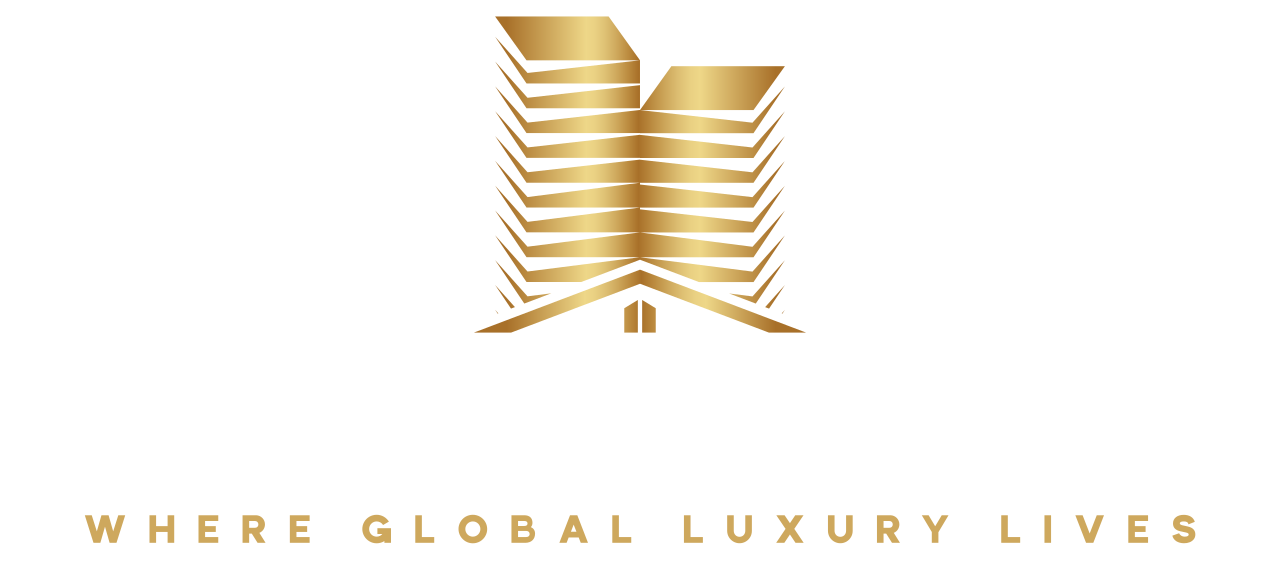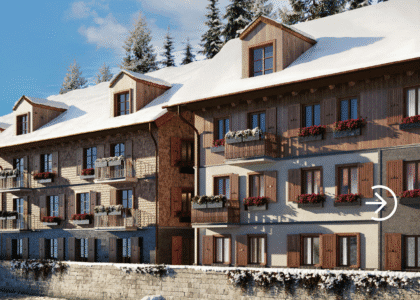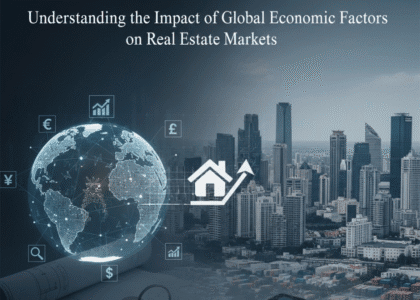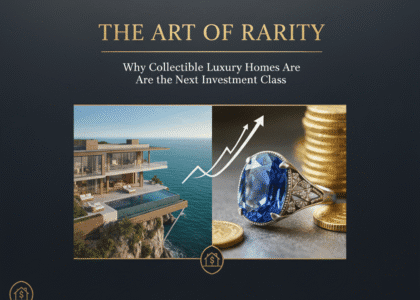Introduction: The New Era of Billionaire Living
Luxury real estate in 2025 has entered a new dimension. The world’s ultra-high-net-worth individuals (UHNWIs) no longer define prestige merely by location or architectural brilliance. For today’s billionaire buyers, luxury homes are curated lifestyle statements, blending privacy, innovation, wellness, sustainability, and cultural legacy into one seamless experience.
These buyers are not purchasing houses; they are investing in elite sanctuaries, global estates, and architectural masterpieces that mirror their identity and safeguard their future. Their demands reflect shifting values—where status meets discretion, technology meets comfort, and exclusivity meets sustainability.
This blog explores the modern billionaire’s wishlist—what the wealthiest buyers expect from luxury homes for sale, international luxury properties, and global luxury estates—and how the upscale property market is evolving to meet these needs.
1. Privacy Above All: The Hidden Sanctuaries of Billionaires
In a hyper-connected world, privacy is the most coveted luxury. Billionaire homes are designed as retreats from visibility, where owners can escape the eyes of the media, public, and even neighbors.
What Privacy Looks Like in 2025
- Ultra-gated estates with multiple checkpoints before reaching the main residence.
- Private islands in the Caribbean, Maldives, or Seychelles, offering seclusion and exclusivity.
- Underground garages and tunnels for discreet arrivals and departures.
- High-walled compounds and advanced landscaping that shield estates from drones and satellite views.
Privacy is no longer an afterthought; it is engineered into the property’s DNA. From biometric access systems to bulletproof glass and underground panic rooms, these estates ensure that the world’s most powerful individuals remain invisible when they wish to be.
Case Insight
Jeff Bezos’ Beverly Hills estate spans multiple acres, carefully landscaped to ensure privacy even from aerial photography. Similar strategies are employed across exclusive homes worldwide, from Beverly Hills to the French Riviera.
2. AI-Powered Smart Homes: Residences That Anticipate
For billionaire buyers, a “smart home” must go far beyond voice-activated lighting or automated blinds. In 2025, the expectation is for AI-driven homes that adapt, predict, and secure.
Features of AI-Integrated Billionaire Homes
- Predictive intelligence that learns daily routines and adjusts climate, lighting, and security.
- Digital concierges that manage private jet bookings, schedule appointments, and coordinate events.
- Advanced cybersecurity to protect digital assets, communications, and personal data.
- Biometric vaults for digital wealth—from cryptocurrency to NFTs.
The ultra-wealthy value homes that act as living systems—residences that prepare themselves for the owner’s arrival, anticipate preferences, and operate as digital fortresses against external threats.
Market Insight
In London and Dubai, luxury property brokers have already begun marketing homes not just by location or square footage but by their AI ecosystem. These systems are as much a selling point as infinity pools or panoramic views.
3. Wellness Estates: Homes as Healing Spaces
Billionaires increasingly view their homes as wellness sanctuaries. Health has become the new measure of wealth, and estates are designed with longevity and well-being at their core.
Wellness Features on the Billionaire Wishlist
- Private medical suites with resident doctors or direct access to global health networks.
- Cryotherapy chambers, flotation tanks, and infrared saunas integrated into personal spas.
- Biohacking facilities with oxygen therapy, stem cell labs, and personalized fitness technologies.
- Wellness kitchens equipped with AI-driven nutrition systems tailored to DNA analysis.
- Outdoor sanctuaries, Zen gardens, and yoga terraces designed for mental balance.
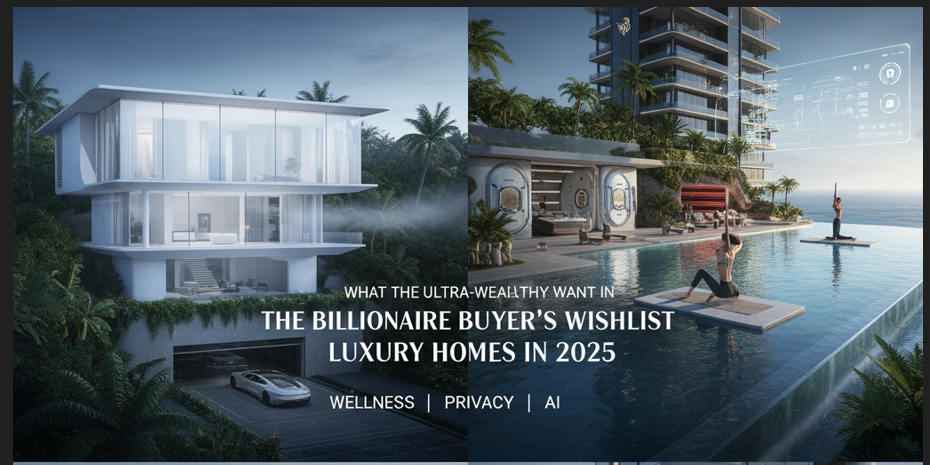
Real-World Example
In Miami, new luxury apartment developments are marketed less by their size and more by their wellness features—purified air systems, circadian lighting, and natural materials that promote restorative living.
For UHNWIs, the home must do more than provide shelter; it must heal, restore, and extend life.
4. Eco-Luxury: Sustainability as a Statement
Sustainability has transformed from a trend to a status symbol. Billionaire buyers demand homes that blend opulence with environmental responsibility.
Eco-Luxury Inclusions
- Net-zero estates powered by renewable energy sources.
- AI-managed irrigation and rainwater harvesting systems.
- Luxury interiors designed with reclaimed woods and rare sustainable materials.
- Properties designed as eco-reserves, including private reforestation projects and protected habitats.
Case Insight
In New Zealand, luxury estates for sale include private eco-reserves, giving buyers not just a home but a personal environmental legacy.
For luxury property specialists, showcasing sustainability is no longer optional; it is central to positioning homes within the upscale property market.
5. Trophy Destinations: Prestige in Location
Beyond the walls of the home, the address itself is part of the billionaire lifestyle. Certain destinations carry a symbolic value that elevates property ownership into a mark of legacy.
Global Hotspots for Billionaire Buyers
- Monaco: Ultra-exclusive, tax-friendly, with unrivaled yachting access.
- Dubai: Home to futuristic skyscrapers and branded residences.
- London: A magnet for heritage estates in Mayfair, Kensington, and Knightsbridge.
- New York: Penthouses on Billionaire’s Row remain global trophies.
- Swiss Alps and Aspen: Seasonal chalets offering exclusivity and retreat.
Example
Properties in Monaco often sell for more per square meter than anywhere else in the world—not for the architecture but for the prestige of belonging to the world’s most exclusive enclave.
For luxury property brokers, location remains the cornerstone of desirability.
6. Branded Residences: Aligning with Global Icons
The surge of branded residences is reshaping billionaire property investments. By linking their homes to iconic brands in fashion, hospitality, or design, buyers secure both prestige and consistent quality.
Why Billionaires Choose Branded Residences
- Access to five-star hotel-style services.
- Interiors designed by globally recognized names like Armani, Versace, or Bugatti.
- Enhanced resale value due to brand equity.
- Communities offering private clubs, art galleries, and elite networking.
Market Example
In Dubai, Bugatti-branded residences include car elevators and waterfront villas—an offering that blends design, exclusivity, and lifestyle branding.
For billionaires, these are not just homes; they are lifestyle partnerships.
7. Billionaire Portfolios: Owning Across Continents
The ultra-wealthy rarely stop at one property. Their portfolios often span continents, designed for flexibility, prestige, and investment protection.
Portfolio Structures
- Coastal luxury villas for sale in global resort towns.
- Luxury apartments for sale in financial capitals for business convenience.
- Historic estates as legacy assets.
- Eco-retreats and mountain chalets for seasonal living.
Case Insight
Global elites, from royal families to tech founders, often maintain 8–12 properties, ensuring they have a home tailored for every season, occasion, or business requirement.
Luxury property advisors play a vital role in managing these portfolios, sourcing off-market opportunities and curating investment strategies.
8. Security and Resilience: Future-Proof Fortresses
Security remains a cornerstone of billionaire living. But beyond protection from intruders, homes are increasingly designed as resilient fortresses.
Security and Resilience Features
- Climate-resistant architecture—hurricane-proof villas, fireproof chalets.
- Underground bunkers with extended survival capacity.
- Biometric vaults for storing art, gold, and cryptocurrency.
- Independent water and power systems to ensure self-sufficiency.
Case Example
Luxury estates in California now include panic rooms with 6-month food and supply reserves, marketed as resilience suites for the uncertain future.
For billionaires, resilience is not luxury—it is peace of mind.
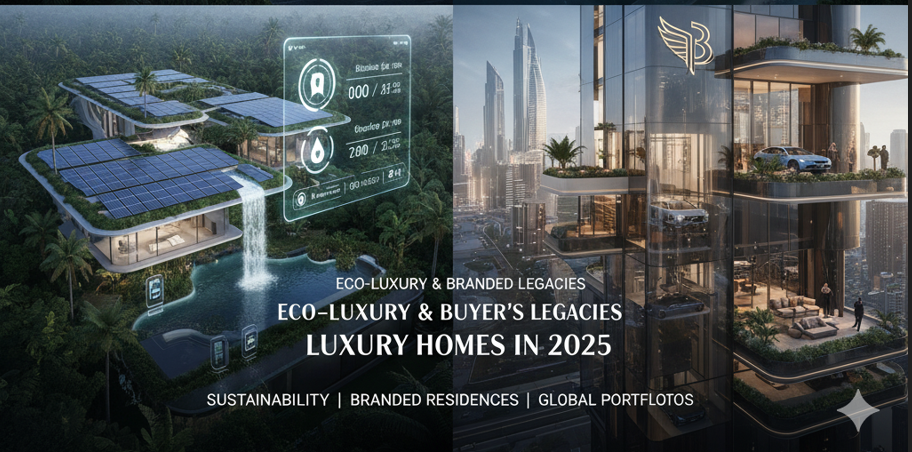
9. The Role of Luxury Property Specialists
Behind every billionaire’s acquisition is an elite network of luxury property consultants, brokers, and advisors. These professionals manage more than transactions—they handle discretion, strategy, and legacy.
Responsibilities of Luxury Property Experts
- Curating exclusive off-market luxury real estate listings.
- Advising on cross-border legal, tax, and inheritance issues.
- Acting as confidants and strategists in long-term wealth planning.
- Facilitating elite networking opportunities between global buyers and sellers.
The billionaire buyer’s trust is hard-earned. Specialists who understand the emotional and financial significance of these acquisitions position themselves as indispensable partners.
Conclusion: Homes as Billionaire Legacies
The modern billionaire’s wishlist reflects the future of global luxury estates. Privacy, technology, wellness, sustainability, and branded experiences now define the most sought-after properties. Each home is no longer a simple residence—it is a statement of legacy, a fortress of security, a wellness sanctuary, and a global investment.
For those navigating the luxury real estate network, understanding these evolving expectations is not optional—it is the key to unlocking opportunities in the elite real estate market.
In 2025 and beyond, billionaire buyers will continue to reshape the definition of luxury living. Their homes will not just stand as architectural masterpieces, but as symbols of identity, resilience, and timeless prestige.
